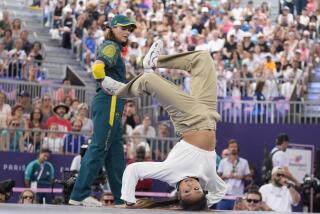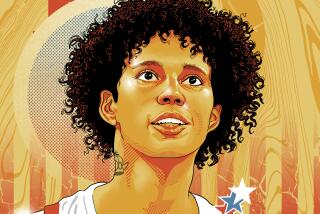X FOR THE GAMES
Unlike world figure skating champion Michelle Kwan and courageous medal-winning skier Picabo Street, most Winter Olympians are not household names--except, perhaps, in their own households.
However, here are 10 athletes (or duos) who are capable of making names for themselves a year from now at the Salt Lake City Winter Games:
GEORG HACKL, LUGE, GERMANY
He’s a legend among sliders. The only luger to win four individual Olympic medals (silver in 1988 and gold in 1992, 1994 and 1998), he has 20 World Cup victories and nine world championship medals.
Hackl, 34, will try to become the first Winter Olympian to win the same individual event four times in a row. Only three Summer Olympians have done so: Carl Lewis (long jump), Al Oerter (discus) and Paul Elvstrom (sailing).
Hackl, known for his good starts and attention to the care and adjustment of his sled, rallied to defeat rival Markus Prock of Austria at the 1992 Albertville Games and again at Lillehammer in 1994. At Nagano in 1998, he had the fastest time in all four runs.
JANICA KOSTELIC, ALPINE SKIING, CROATIA
Nicknamed the “Croatian Sensation,” she returned from reconstructive knee surgery in December 1999 to own World Cup slalom racing.
Kostelic, 19, won seven consecutive slaloms this season to tie a record set in 1993 by Vreni Schneider of Switzerland. She has won nine consecutive slaloms overall, including two before she blew out her knee and shredded ligaments during a training run. She was leading the overall World Cup standings when she was hurt.
Kostelic and her family fled their native Zagreb and their war-torn homeland and for a while slept in their car at the foot of the glaciers she trained on. As a junior, she won all 22 races she entered.
APOLO ANTON OHNO, SHORT-TRACK SPEEDSKATING, UNITED STATES
Speedskating has been a reliable source of medals for the U.S. Bonnie Blair won five golds and a bronze in 1988, 1992 and 1994, and Dan Jansen got his gold medal in 1994, after much adversity. Since 1960, the U.S. has been shut out of speedskating medals only once, in 1984.
The addition of short-track speedskating in 1992 seemed to be another mother lode when Cathy Turner won the 500 in 1992 and 1994 and men’s and women’s relay teams brought home two silvers and two bronzes.
But the U.S. won no short-track medals at Nagano in 1998, and only long tracker Chris Witty (silver in the 1,000 and bronze in the 1,500) made it to the podium.
The short-track slump could be ended by Ohno, an 18-year-old Seattle native who holds U.S. records in the 500 (41.916 seconds), 1,000 time trial (1:27.775) and 1,500 (2:15.977). He set the 500 and 1,500 records this season in winning three overall World Cup championships, the overall World Cup crown and the season championships at 1,000 and 1,500 meters.
A former in-line skater and state-champion breaststroke swimmer, he became the youngest American to win a World Cup race in December 1999, when he was 17 and won the 1,500 at Chang Chun, China. He was the 1998-99 world junior short-track champion and the U.S. junior short-track champion for 1999-2000.
EVGENI PLUSHENKO, FIGURE SKATING, RUSSIA
Skaters from the former Soviet Union have won the last three men’s Olympic gold medals--1992 winner Viktor Petrenko of Ukraine competed for the Unified Team during the breakup of the country--and that streak has a good chance to continue at Salt Lake City.
But will the winner be Plushenko or three-time world champion Alexei Yagudin, both Russians?
Plushenko, 18, appears to have gained a slight edge. He won the Russian and European championships this season, besides winning the Cup of Russia in mid-November and the NHK trophy in early December. He lost to Yagudin only once, at the Japan Open in January.
Plushenko is the only skater in the world to do a quadruple toe loop-triple toe loop-double loop combination. The technical content of his short and long programs is unmatched.
ALEXEI YAGUDIN, FIGURE SKATING, RUSSIA
Another master of the quadruple jump, this 20-year-old Leningrad native moved to Newington, Conn., late last year to train at the Connecticut Skating Center under legendary coach Tatiana Tarasova.
Like Plushenko, he’s technically skilled and impresses judges with his artistry. He won Skate Canada in early November and the Lalique Trophy competition in France a few weeks later to qualify for the Grand Prix final next week.
Nearly fluent in English, he’s an intriguing blend of traditional Russian dance technique and Western free spirit. He was fifth at Nagano.
DARON RAHLVES, ALPINE SKIING, UNITED STATES
When the Truckee, Calif., resident carried the U.S. flag into the stadium for the world Alpine skiing championships in Austria last week, he didn’t expect he’d also uphold the honor of the U.S. team on the slopes.
Rahlves, 27, shocked heavily favored Austrians Hermann Maier and Stephan Eberharter to win the super-G and become the first American man to win a world championship in skiing since Steve Mahre won the 1982 giant slalom. He showed promise last season, when he won back-to-back World Cup downhill races in Kvitfjell, Norway, and became the first American man to record a World Cup victory since Kyle Rasmussen in 1995. But he struggled early this season and couldn’t have predicted he would prevail at St. Anton.
“I think we [Americans] just rise to the occasion for big races,” said Rahlves, who finished fifth Wednesday in the downhill. “It’s nothing special, just keeping it simple.”
JEAN RACINE AND JEN DAVIDSON, BOBSLED, UNITED STATES
The most successful U.S. women’s bobsled team came together by sheer coincidence--but their pairing is expected to make driver Racine and brakeman Davidson winners of the first Olympic women’s bobsled gold medal.
Racine, 22, was a member of the U.S. junior luge team in 1996 when she decided to switch to bobsledding. At the time, women’s bobsled wasn’t on the Olympic program and the U.S. women’s bobsled team lacked uniforms and didn’t have its own sleds.
Davidson, 28, was a track and field sprinter and hurdler at Utah State. On a whim, she answered an ad for bobsledders and made it to the team trials at Lake Placid, N.Y., on her athleticism.
Her first few rides were bruising. But three months later, Davidson and Racine won a silver medal in their first World Cup race. They have won all five of their World Cup races this season.
JAMIE SALE AND DAVID PELLETIER, PAIRS FIGURE SKATING, CANADA
Sale, a 23 year-old Calgary native, and Pelletier, from the Quebec town of Sayabec, are born entertainers. Both were singles skaters before switching to pairs in 1992. She’s vivacious, he’s strong technically, and their charisma has won approval from fans and judges.
Since they found each other again in the summer of 1998 and Sale moved to Montreal to train with Pelletier, they’ve made a quantum leap up the figure skating ladder. They were third in their competitive debut, at Skate Canada in 1998, and won Skate America in 1999. They won the Canadian pairs title in 2000 and finished fourth at the World Championships.
“The chemistry we have and the way we skate, it’s amazing,” said Sale, who has acknowledged they are a couple off the ice. “I never thought I would find this match.”
IRINA SLUTSKAYA, FIGURE SKATING, RUSSIA
A Moscow native, Slutskaya won the world junior title in 1995 and a year later became the first Russian or Soviet woman to win the European championship. She has added four more European titles, a third-place finish at the 1996 world championships and second-place finishes in 1998 and 2000.
Slutskaya (pronounced Sloot-SKY-ah), who turned 22 Wednesday, appears to have surpassed Russian compatriot Maria Butyrskaya because of her consistency and technical superiority. Slutskaya and Butyrskaya finished 1-2 in the Russian championships, the European championships and the NHK trophy competition this season, although Butyrskaya reversed that in the Japan Open in early January.
Slutskaya, fifth at the 1998 Nagano Games, is considered the chief obstacle between five-time U.S. champion Kwan and a gold medal.
KRISSY WENDELL, WOMEN’S HOCKEY, UNITED STATES
Although she wears makeup on the ice, Krissy Wendell didn’t win her Ms. Minnesota title in a beauty pageant.
This 5-foot-6, 155-pound forward gained that honor for scoring 110 goals and 166 points in 27 games her senior year of high school in Brooklyn Park, Minn., capping a career in which she scored 231 goals and 335 points in 62 games. That includes 12 goals and 20 points in 10 games with the boys’ team in 1997-98.
Wendell, 19, is among the youngest members of Team USA. She brings speed, strength and enthusiasm, traits the U.S. will need to hold off longtime rival Canada and the rapidly improving Finns and repeat its historic 1998 success.
“I think she will be the type of athlete who is going to leave a pretty big footprint on the sport,” Team USA Coach Ben Smith said.
Wendell was the top scorer at the 2000 women’s world championships with two goals and 13 points in five games.
More to Read
Go beyond the scoreboard
Get the latest on L.A.'s teams in the daily Sports Report newsletter.
You may occasionally receive promotional content from the Los Angeles Times.







